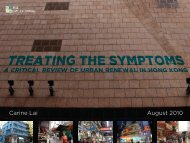Untitled - Civic Exchange
Untitled - Civic Exchange
Untitled - Civic Exchange
You also want an ePaper? Increase the reach of your titles
YUMPU automatically turns print PDFs into web optimized ePapers that Google loves.
ASUSTAINABLE TRANSPORT POLICY<br />
1<br />
"The term sustainable development was introduced in 1980, popularized in the 1987 report of<br />
the World Commission on Environment and Development (the Brundtland Commission), and<br />
given the status of a global mission by the United Nations Conference on Environment and<br />
Development (UNCED) held in Rio de Janeiro in 1992." 6<br />
The concept of sustainable development has now been widely adopted as a legitimate planning goal. In<br />
essence, sustainable development focuses on improving (and maintaining) the quality of life for all<br />
inhabitants of the Earth without increasing the use of natural resources beyond the capacity of the natural<br />
environment to supply them indefinitely. This concept takes into account the fact that innovative ways need<br />
to be found to change institutional structures and influence individual behavior. The practice of sustainable<br />
development requires taking action and changing policy and practice at all levels - at the individual and<br />
national, as well as the international, level. 7<br />
Although sustainable development initially emphasized resource conservation, 8 the concept has gradually<br />
evolved to encompass a broader range of issues, including transport. 9 Transport is key to prosperity as well<br />
as to sustainability and has attracted special attention in recent years. This chapter provides a brief<br />
overview of the international debate on sustainable transport and summarizes the essential elements of<br />
what constitutes a sustainable transport policy.<br />
1.1 A sustainable transport policy<br />
Transport is central to economic growth and social development. On the one hand, it facilitates the<br />
movement of raw materials and freight at the international, national, regional, and local levels. On the other<br />
hand, it facilitates the movement of people and the diffusion of ideas and knowledge. As transport is a prerequisite<br />
for growth, an enormous sum of money has been invested in major transport infrastructure<br />
projects all over the world during the last few decades.<br />
Over roughly the same period, motorized transport has become an integral part of people's daily lives by<br />
providing the means to get to jobs, amenities, and leisure facilities. Public transport services, as well as<br />
personal modes of transport such as private cars and motorcycles, connect people with one another. Indeed,<br />
private vehicles have become the icon of a "modern" lifestyle that emphasizes personal mobility and<br />
individual freedom. In an urban context, prosperity, car ownership, highway construction, and dispersed<br />
land use patterns reinforce one another. Consequently, improved mobility serves and shapes urban sprawl.<br />
6<br />
Kageson, cited in Organization for Economic Cooperation and Development (OECD) (1997), Towards<br />
Sustainable Transportation, Proceedings of the Vancouver Conference held in March 1996, organized by the OECD<br />
and hosted by the Government of Canada.<br />
7<br />
SD Gateway at , section on definitions of sustainable development.<br />
8<br />
According to Haq, the term sustainable development was first brought forward by the World Conservation<br />
Strategy (WCS) in 1980, which explained the contribution of resource conservation to human survival and to<br />
sustainable development. Haq, G. (1997), Towards Sustainable Transport Planning: A Comparison between Britain<br />
and the Netherlands, Aldershot: Ashgate, p.6.<br />
9 In 1987, the World Commission on Environment and Development (WCED) report, Our Common Future<br />
(commonly known as the Brundtland Report), defined sustainable development as "development that meets the<br />
needs of the present without compromising the ability of future generations to meet their own needs." The Report<br />
weaves together social, economic, cultural, and environmental issues with global solutions and also highlights the<br />
notion of intra-generational and inter-generational equity. WCED (1987), Our Common Future, Oxford: Oxford<br />
University Press, p.8.<br />
5

















